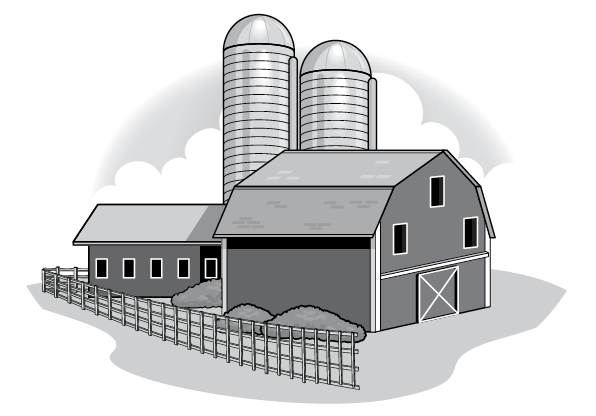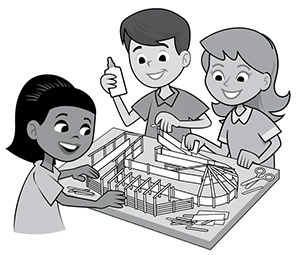Build it Better
Students investigate animal handling preferences, design a cattle corral system that is durable, efficient, and effective, and discover the skills needed to be an agricultural engineer.
Background
Lesson Activities
Recommended Companion Resources
Credits
Author
Mandi Bottoms and Sherrie Taylor Vann | California Foundation for Agriculture in the Classroom
Acknowledgements
This lesson was funded in 2012 by the United States Department of Agriculture’s National Institute of Food and Agriculture through the Secondary Education, Two-Year Postsecondary Education, and Agriculture in the K-12 Classroom Challenge Grants Program (SPECA). Graphics submitted by California Foundation for Agriculture in the Classroom.
Executive Director: Judy Culbertson
Illustrator: Erik Davison
Layout and Design: Nina Danner
Standards
Texas Content Area Standards
-
Technology Applications: 3-5.126.7.b.1
Creativity and innovation. The student uses creative thinking and innovative processes to construct knowledge and develop digital products.
- Technology Applications: 3.126.b.1.B: The student is expected to analyze trends and forecast possibilities, developing steps for the creation of an innovative process or product.
-
ELA: 3.110.5.b.6
Comprehension skills: listening speaking, reading, writing and thinking using multiple texts. The student uses metacognitive skills to both develop and deepen comprehension of increasingly complex texts.
- ELA: 3.6.G: The student is expected to evaluate details read to determine key ideas.
-
ELA: 3.110.5.b.7
Response skills: listening, speaking, reading, writing, and thinking using multiple texts. The student responds to an increasingly challenging variety of sources that are read, heard, or viewed.
- ELA: 3.7.E: The student is expected to interact with sources in meaningful ways such as notetaking, annotating, freewriting, or illustrating.
- ELA: 3.7.F: The student is expected to respond using newly acquired vocabulary as appropriate.
-
ELA: 3.110.5.b.13
Inquiry and research: listening, speaking, reading, writing, and thinking using multiple texts. The student engages in both short-term and sustained recursive inquiry processes for a variety of purposes.
- ELA: 3.13.C: The student is expected to identify and gather relevant information from a variety of sources.
- ELA: 3.13.E: The student is expected to demonstrate understanding of information gathered.
- ELA: 3.13.H: The student is expected to use an appropriate mode of delivery, whether written, oral, or multimodal, to present results.
-
ELA: 4.110.6.b.1
Developing and sustaining foundational language skills: listening, speaking, discussion, and thinking- oral language. The students develops oral language through listening, speaking, and discussion.
- ELA: 4.1.D: The student is expected to work collaboratively with other to develop a plan of shared responsibilities.
-
ELA: 4.110.6.b.6
Comprehension skills: listening, speaking, reading, writing and thinking using multiple texts. The student uses metacognitive skills to both develop and deepen comprehension of increasingly complex texts.
- ELA: 4.6.G: The student is expected to evaluate details read to determine key ideas.
-
ELA: 4.110.6.b.7
Response skills: listening, speaking, reading, writing, and thinking using multiple texts. The student responds to an increasingly challenging variety of sources that are read, heard, or viewed.
- ELA: 4.7.E: The student is expected to interact with sources in meaningful ways such as notetaking, annotating, freewriting, or illustrating.
- ELA: 4.7.F: The student is expected to respond using newly acquired vocabulary as appropriate.
-
ELA: 4.110.6.b.13
Inquiry and research: listening, speaking, reading, writing, and thinking using multiple texts. The student engages in both short-term and sustained recursive inquiry processes for a variety of purposes.
- ELA: 4.13.C: The student is expected to identify and gather relevant information from a variety of sources.
- ELA: 4.13.E: The student is expected to identify primary and secondary sources.
- ELA: 4.13.H: The student is expected to use an appropriate mode of delivery, whether written, oral, or multimodal, to present results.
-
ELA: 5.110.7.b.1
Developing and sustaining foundational language skills: listening, speaking, discussion, and thinking- oral language. The students develops oral language through listening, speaking, and discussion.
- ELA: 5.1.C: The student is expected to give an organized presentation employing eye contact, speaking rate, volume, enunciation, natural gestures, and conventions of language to communicate ideas effectively.
- ELA: 5.1.D: The student is expected to work collaboratively with others to develop a plan of shared responsibilities.
-
ELA: 5.110.7.b.6
Comprehension skills: listening, speaking, reading, writing, and thinking using multiple texts. The student uses metacognitive skills to both develop and deepen comprehension of increasingly complex texts.
- ELA: 5.6.G: The student is expected to evaluate details read to determine key ideas.
-
ELA: 5.110.7.b.7
Response skills: listening, speaking, reading, writing, and thinking using multiple texts. The student responds to an increasingly challenging variety of sources that are read, heard, or viewed.
- ELA: 5.7.E: The student is expected to interact with sources in meaningful ways such as notetaking, annotating, freewriting, or illustrating.
- ELA: 5.7.F: The student is expected to respond using newly acquired vocabulary as appropriate.
-
ELA: 5.110.7.b.13
Inquiry and research: listening, speaking, reading, writing, and thinking using multiple texts. The student engages in both short-term and sustained recursive inquiry processes for a variety of purposes.
- ELA: 5.13.C: The student is expected to identify and gather relevant information from a variety of sources.
- ELA: 5.13.E: The student is expected to demonstrate understanding of information gathered.
- ELA: 5.13.H: The student is expected to use appropriate mode of delivery, whether written, oral, or multimodal, to present results.
-
Math: 4.111.6.b.8
Geometry and measurements. The student applies mathematical process standards to select appropriate customary and metric units, strategies, and tools to solve problems involving measurement.
- Math: 4.8.C: The student is expected to solve problems that deal with measurements of length, intervals of time, liquid volumes, mass, and money using addition, subtraction, multiplication, or division as appropriate.
-
Math: 5.111.7.b.7
Geometry and measurement. The student applies mathematical process standards to select appropriate units, strategies, and tools to solve problems involving measurement. The student is expected to solve problems by calculating conversions within a measurement system, customary or metric.
- Math: 5.b.7: Geometry and measurement. The student applies mathematical process standards to select appropriate units, strategies, and tools to solve problems involving measurement. The student is expected to solve problems by calculating conversions within a measurement system, customary or metric.
-
Social Studies: 3.113.14.c.15
Social studies skills. The student communicates in written, oral, and visual forms. The student is expected to:
- Social Studies: 3.113.14.c.15.D: express ideas orally based on knowledge and experiences
-
Social Studies: 3.113.14.c.16
Social studies skills. The student uses problem-solving and decision-making skills, working independently and with others. The student is expected to:
- Social Studies: 3.113.14.c.16.B: use problem-solving and decision-making processes to identify a problem, gather information, list and consider options, consider advantages and disadvantages, choose and implement a solution, and evaluate the effectiveness of the solution
-
Social Studies: 4.113.15.c.21
Social studies skills. The student communicates in written, oral, and visual forms. The student is expected to:
- Social Studies: 4.113.15.c.21.C: express ideas orally based on research and experiences
- Social Studies: 4.113.15.c.21.D: create written and visual material such as journal entries, reports, graphic organizers, outlines, and bibliographies
- Social Studies: 4.113.15.c.21.E: apply foundational language skills to engage in civil discourse about social studies topics, including those with multiple perspectives
-
Social Studies: 4.113.15.c.22
Social studies skills. The student uses problem-solving and decision-making skills, working independently and with others. The student is expected to:
- Social Studies: 4.113.15.c.22.B: use problem-solving and decision-making processes to identify a problem, gather information, list and consider options, consider advantages and disadvantages, choose and implement a solution, and evaluate the effectiveness of the solution
-
Social Studies: 5.113.16.c.25
Social studies skills. The student communicates in written, oral, and visual forms. The student is expected to:
- Social Studies: 5.113.16.c.25.C: express ideas orally based on research and experiences
- Social Studies: 5.113.16.c.25.D: create written and visual material such as journal entries, reports, graphic organizers, outlines, and bibliographies
- Social Studies: 5.113.16.c.25.E: apply foundational language skills to engage in civil discourse about social studies topics, including those with multiple perspectives
-
Social Studies: 5.113.16.c.26
Social studies skills. The student uses problem-solving and decision-making skills, working independently and with others. The student is expected to:
- Social Studies: 5.113.16.c.26.B: use problem-solving and decision-making processes to identify a problem, gather information, list and consider options, consider advantages and disadvantages, choose and implement a solution, and evaluate the effectiveness of the solution
-
Technology Applications: 126.8.c.1
Computational thinking--foundations. The student explores the core concepts of computational thinking, a set of problem-solving processes that involve decomposition, pattern recognition, abstraction, and algorithms. The student is expected to:
- Technology Applications: 126.8.c.1.A: decompose story problems into smaller, manageable subproblems and identify a solution to the problems
- Technology Applications: 126.8.c.1.C: develop a plan collaboratively and document a plan that outlines specific steps taken to complete a project
-
Technology Applications: 126.8.c.5
Data literacy, management, and representation--collect data. The student uses digital strategies to collect and identify data. The student is expected to:
- Technology Applications: 126.8.c.5.A: identify and collect numerical data such as the price of goods or temperature
- Technology Applications: 126.8.c.5.B: use various search strategies with adult assistance
-
Technology Applications: 126.8.c.6
Data literacy, management, and representation--organize, manage, and analyze data. The student uses data to answer questions. The student is expected to analyze data in graphs to identify and discuss trends and inferences.
- Technology Applications: 126.8.c.6: Data literacy, management, and representation--organize, manage, and analyze data. The student uses data to answer questions. The student is expected to analyze data in graphs to identify and discuss trends and inferences
-
Technology Applications: 126.9.c.1
Computational thinking--foundations. The student explores the core concepts of computational thinking, a set of problem-solving processes that involve decomposition, pattern recognition, abstraction, and algorithms. The student is expected to:
- Technology Applications: 126.9.c.1.A: decompose story problems into smaller, manageable subproblems and discuss and document various solutions to the problems
- Technology Applications: 126.9.c.1.C: communicate design plans and solutions using a variety of options
-
Technology Applications: 126.9.c.6
Data literacy, management, and representation--organize, manage, and analyze data. The student uses data to answer questions. The student is expected to use digital tools to transform and make inferences about data to answer a question.
- Technology Applications: 126.9.c.6: Data literacy, management, and representation--organize, manage, and analyze data. The student uses data to answer questions. The student is expected to use digital tools to transform and make inferences about data to answer a question
-
Technology Applications: 126.10.c.1
Computational thinking--foundations. The student explores the core concepts of computational thinking, a set of problem-solving processes that involve decomposition, pattern recognition, abstraction, and algorithms. The student is expected to:
- Technology Applications: 126.10.c.1.A: decompose a real-world problem into smaller, manageable subproblems using graphic organizers such as learning maps, concept maps, or other representations of data
-
Technology Applications: 126.10.c.6
Data literacy, management, and representation--organize, manage, and analyze data. The student uses data to answer questions. The student is expected to use digital tools to analyze and transform data and make inferences to answer questions.
- Technology Applications: 126.10.c.6: Data literacy, management, and representation--organize, manage, and analyze data. The student uses data to answer questions. The student is expected to use digital tools to analyze and transform data and make inferences to answer questions

